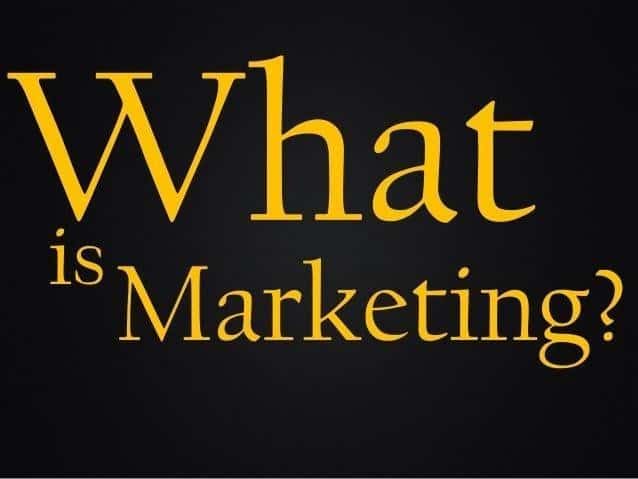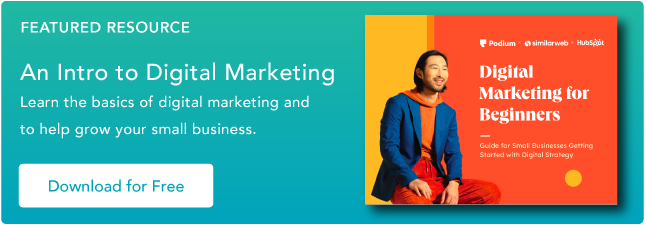Marketing is a business term that experts have defined in dozens of different ways. In fact, even at company level people may perceive the term differently. Basically, it is a management process through which products and services move from concept to the customer. It includes identification of a product, determining demand, deciding on its price, and selecting distribution channels. It also includes developing and implementing a promotional strategy incorporating both outbound and inbound marketing.
Collins Dictionary has the following definition of the term:
“Marketing is the organization of the sale of a product, for example, deciding on its price, the areas it should be supplied to, and how it should be advertised.”
Below is the American Marketing Association’s definition:
“Marketing is the activity, set of institutions, and processes for creating, communicating, delivering, and exchanging offerings that have value for customers, clients, partners, and society at large.”
Marketing refers to the activities of a business related to buying and selling a product or service. It involves finding out what consumers want and determining whether it is possible to produce it at the right price. The company then makes and sells it.
Marketing covers a vast area of business, including:
- how you communicate
- the brand
- the design
- pricing
- market research
- consumer psychology
- measuring effectiveness
At the core of marketing is an understanding of what customers need and value. A company’s long-term success depends on learning what its customers’ needs are. It then finds ways to add value through different approaches.
Business-to-business marketing
This involves targeting other businesses. We also call it business-to-business or B2B marketing. It involves supplying other companies with products or services.
Physical products that companies sell to other businesses are ‘industrial goods.’ Industrial goods may include raw materials for companies that make plastics, yarn for use in the textile trade. It also includes aircraft for airlines and the military.
In fact, the term ‘industrial goods’ refers anything a company or organization needs and buys.
B2B services may include legal advice, management consultancy, tax consultancy, or training provision. IT services and the provision of temporary staff are also examples of B2B services. IT stands for Information Technology.
If you’re interested in B2B Marketing, you’d need a LinkedIn account. Here’s a post on the best practices to manage multiple LinkedIn accounts.
Marketing directly to consumers
We also call it B2C. The term refers to targeting the individual people who purchase products and use services. Specifically, people who bought for their own consumption.
This may include FMCGs (fast-moving consumer goods) such as food, beverages, and toiletries, or durable goods. For example, cars, televisions, refrigerators and other white goods are durable goods. ‘White goods’ are major appliances that traditionally have had a white enamel surface.
B2B + B2C marketing
Most large corporations have an integrated marketing approach. In other words, they focus on both individual consumers and businesses at the same time.
The Coca-Cola company, for example, knows that its B2C marketing must succeed. Put simply; it has to persuade supermarkets and smaller stores – B2B – to provide shelf space.
Most makers of durable goods also have an integrated marketing approach. For example, The Haier Group focuses on individual consumers (B2C). However, it also focuses on supermarkets, department stores, and other retail outlets (B2B). The Haier Group is world’s largest manufacturer of consumer electronics and home appliances.
Recruitment marketing
Recruitment marketing includes all the tools and strategies that employers use to engage, attract, and eventually hire talented people. The aim is to encourage people to want to join the organization.
The practice takes advantage of data analytics, omnichannel communication, social media platforms, and other digital marketing strategies.
According to Adrian Cernat, CEO and co-founder of SmartDreamers:
“Recruitment marketing is the process of trying to attract and hire talented people. It includes the strategies and tactics that employers use to attract, engage, and nurture talented personnel before they apply for a job.”
Marketing strategy
A company’s marketing strategy should combine all its objectives into one integrated and comprehensive plan. In other words, it should not focus on one strategy at the expense of others.
It should use market research data to create its strategy. The company should focus on the ideal product mix to reach the optimum profit potential. The right product mix is also crucial to sustaining the business.
According to marketingstrategynow.com: “The best marketing strategy process allows you to specially target your products and services to the ideal buyers most likely to buy.”
An effective and successful marketing plan depends on a good strategy. A company’s strategy should begin with the setting of objectives that will support its overall aims.
It then needs to come up with a strategy that allows it to reach these objectives.
According to CIM:
“The strategy may involve research into product or service development, how the product or service will reach the market (channels) and how the customers will find out about it (communication).”
“It will also attempt to define a unique positioning for the product or business to differentiate it from its competitors.”
Fundamentally, sales and marketing are trying to achieve the same thing. In other words, they are trying to get more customers and revenues. However, they look at things slightly differently. Put simply; marketing focuses on the market, while sales focuses on the product. Sales also focuses on how to persuade consumers to like it and buy it. Some sales managers disagree with the image above, insisting that sales does continue after the sale of the product.
Typical marketing divisions
There are many divisions of marketing. Not all companies have the same names for each one. Below is a list of the most common divisions (Source: London School of Economics):
Advertising
Advertising involves promoting an idea or product into the marketplace by placing ads in the media.
Community Involvement
The term means working with the local community. This is not only good for the company’s standing locally, and as a way of growing customer loyalty, but it is also great for morale within the firm
Examples include sponsoring local events, chairing meetings, volunteering in schools or local youth centers, and belonging to local associations.
Customer Service
Basically, this involves providing assistance and advice to people who purchased the product. In many business, sellers also provide this service to customers before, during, and after a sale.
Good customer service produces satisfied customers. In other words, their experience meets or exceeds their expectations. If your competitors have good customer service and you don’t, you will probably lose market share to them.
Direct Marketing
This approach involves delivering your message directly to consumers via leaflets, forms, fliers, catalogs, as well as street promotion.
Distribution
Distribution is part of the management chain. It involves transporting one product from storage to a shop or supermarket.
Market Research
Market research is the process of gathering and analyzing information. The data will make the company more aware of how people will react to its current and future products.
Business owners are conducting market research all the time. When they talk to customers about their business, they are conducting market research. Whenever somebody tries to find out what the competition is doing, they are conducting market research.
Good market research can produce a wealth of data about the business’ products, customers, and the marketplace.
Media Planning
Media planning is closely-related to advertising. It is an advertising strategy we employ to target consumers using a range of informational outlets.
Advertising or media planning agencies usually conduct this kind of work. They find the best media outlets to reach the target market.
Examples of media outlets include the internet, posters, television, radio, physical newspapers and magazines, etc.
Product pricing
When setting the price, you should take into account how much something costs to produce and deliver. You should also consider how much competitors are selling it for, its quality, the brand, etc.
Most product prices rarely stay the same for long. Production costs may change, salaries can rise, or competitors might suddenly offer discounts or raise their prices. You need to be aware of every factor that influences price all the time.
Public Relations
“A strategic communication process that builds mutually beneficial relationships between organizations and their publics,” says the PRSA.
Sales
Sales includes planning and supporting the sales team by pushing ahead with sales targets. It also involves formulating a plan as to how to reach potential and existing customers. Salespeople aim to hit those targets.
One-to-One Marketing
One-to-one marketing involves communicating directly with each customer. The company then tailors the approach to each customer’s tastes and preferences.
Impression Management
Impression management is the process of shaping people’s perceptions of things, other people, places and events.
In marketing and sales, it means getting consumers to perceive your products or services in a good light.
The Internet and marketing
With the advent of the Internet and ad-blocking software, inbound marketing has become increasingly popular. It involves using content – newsletters, blogs, podcasts, reviews, etc. – that online users like, to lure them in.
In the past, company’s sales personnel used to be the experts. However, today the experts are the consumers.
A term that Internet marketing specialists use all the time is the ‘bounce rate.’ The bounce rate refers to the percentage of people who leave the website after visiting a page.
In other words, instead of going to another page within the same site, they leave – they bounce out. The lower the bounce rate, the better.
Global Marketing refers to the planning, creating, placing, and promoting a business’ goods or services in the worldwide market. Is is a specialized skill. Executives who manage to implement an effective strategy, can take their company to the next level.
During the 1960s and 1970s, many Japanese business practices emerged, which later spread across the world. In some cases, engineering and marketing overlapped. For example, Kansei Engineering is engineering that is based on human emotions. Not only do Kansei developers focus on what products can do, but also on how they make consumers feel.
Marketing principles
Marketing principles are agreed-upon marketing ideas that sellers use for a successful marketing strategy. We also refer to it as the principles of marketing.
Some companies follow the 4Ps Strategy of product, price, place, and promotion. We also refer to it as the 4P Marketing Mix. Others, on the other hand, may follow the 7Ps Strategy of product, place, price, promotion, people, physical environment, and process.
Video – Introduction to Marketing
This video provides a very brief and easy-to-understand explanation of the basic concepts of marketing:
Have you just launched a new product or service that you want to get the word out about? Maybe you want to share with consumers why it is awesome and how it is so much better than the one your competitors offer.
Well, then, there is one thing you can’t do without…Marketing!
A well-thought-out marketing strategy is essential if you want to stand out and ensure the growth of your business.
For most people, marketing means advertising—in magazines, on billboards, social media channels, or on television. But marketing is much more. In fact, it encompasses so many tactics (social media marketing, email marketing, referral marketing, etc.) that we can’t explain all of the elements of the marketing process in this one post.
However, we will shed some light on this broad topic and focus on:
- the definition of marketing
- commonly used marketing terms
- the importance of marketing
- the types & principles of marketing
- examples of successful marketing techniques
- marketing tips & more
Sounds good? Great ☺️ Let’s get started.
Table of Contents
-
What Is Marketing?
-
7 Marketing Terms Everyone Should Know
-
What Is the Main Purpose of Marketing?
-
Marketing & the Role of the Customer
-
Types of Marketing
-
Marketing Mix: The Principles & Practice of Marketing
-
Marketing Done Right: Examples of a Successful Marketing Strategy
-
5 Marketing Tips to Boost Your Business [2023]
-
From Zero to Marketing Superhero – with Meltwater
There are as many fish in the sea as there are definitions of marketing.
So, how do you explain marketing?
At a fundamental level, marketing is the process of understanding your consumer as well as building or maintaining customer relationships.
We have dug out a few quotes from the World Wide Web to give you a better idea of what marketing actually is.
Marketing is the activity, set of institutions, and processes for creating, communicating, delivering, and exchanging offerings that have value for customers, clients, partners, and society at large.
According to Philip Kotler, the «Father of Modern Marketing», it is …
…the science and art of exploring, creating, and delivering value to satisfy the needs of a target market at a profit. Marketing identifies unfulfilled needs and desires. It defines, measures and quantifies the size of the identified market and the profit potential. It pinpoints which segments the company is capable of serving best, and it designs and promotes the appropriate products and services.
If you do not work in Marketing, then you still may be wondering: What do people in marketing do? As the definitions above try to explain, marketers try to attract customers that might be interested in buying a firm’s product or service through highly targeted messaging and communications or advertising. Marketers use several different channels to try and reach consumers, and there are certain marketing terms that often pop up when explaining these various methods of messaging delivery, for example:
- traditional marketing
- digital marketing
- direct marketing
- inbound marketing
But what exactly do they mean?
Keep reading to find out.
7 Marketing Terms Everyone Should Know
By now, you already might have sensed that marketing is a complex topic consisting of numerous concepts and terms. Especially for beginners, this can be a bit overwhelming and confusing.
Therefore, we have prepared a short glossary of 77 important marketing terms which every marketer should be familiar with.
1. Traditional Marketing
Simply put, traditional marketing establishes a connection with the customer via offline advertising channels, e.g.:
- Word-of-Mouth marketing
- television
- magazines and newspapers (print ads)
- posters
- billboards
- banners
- radio
Marketers engaging in traditional advertising practices aim is to reach the masses—after all, the more people are watching your TV ad or reading an article about your product or service, the higher the chance you will attract more leads and boost your sales.
2. Digital Marketing
In comparison with traditional methods, a digital marketing strategy refers to online marketing efforts.
When a marketing department is focused on engaging and reaching potential new or existing customers via the Internet, the team will be using marketing channels like:
- social media platforms
- Google Ads
- email (email marketing)
- corporate websites
- Smart TVs
Your customers may only be active on online channels, offline channels, or, most likely, a mix of both. To figure out what’s the right mix of traditional and digital marketing to engage in, companies often hire a digital marketing agency to help them reach their target audience so that they can build strong customer relationships.
Once you know where to find your customers, consider creating an omnichannel marketing strategy.
3. Direct Marketing
Direct marketing can be seen as a presentation of your company, product, or service to your target customers. It aims to find, reach and motivate customers to take action—by buying your product. Oftentimes, the call-to-action for the consumer is the buy or try your product or service, which isn’t necessarily the same with traditional and digital marketing campaigns that may focus more on brand awareness.
Direct marketing includes not only traditional (TV commercials, radio spots, magazine ads, etc.) as well as digital marketing strategies (email marketing, search engine advertising, etc.).
Trade shows, marketing conferences, and fairs can also serve as great occasions for promoting your business directly to customers.
Here is a fictional example of direct marketing:
Teen magazine subscribers are presented with skincare display advertisements on Facebook, Instagram & Co.
Why?
Because it is commonly known that teenagers often struggle with their skin and are therefore more likely to buy a skin care product compared to other age groups.
4. Inbound Marketing
In simple terms, inbound marketing (or pull marketing) is the process of helping your target audience find you and your business, for example via search engines.
It is focused on nurturing customer relationships, building the brand, and raising brand awareness by gaining the trust of (potential) customers.
You can do this for example by creating relevant, educational, entertaining content. If you establish some kind of communication with the target audience if people are engaging with your content, the chance of them converting to customers increases.
When done correctly, inbound marketing can give you much better results than for example traditional marketing methods.
Why?
Because your customers don’t feel like they are being sold to.
Here are some examples of inbound marketing:
Tip: Already a simple engagement in a discussion on social media platforms or posting a link to an informative article can work miracles for your business.
5. Outbound Marketing
In contrast, outbound marketing (also known as push marketing) consists of traditional methods, such as direct mail, cold calling, radio or television ads, telemarketing, etc.
In other words: A marketer reaches out to people and establishes communication with them to see if they’re interested in a product or service.
Another term for it is interruption marketing.
And we all have experienced it at some point…
…Being interrupted by an unwanted telemarketing call while enjoying a delicious meal or a cup of coffee. Sounds familiar?
6. B2B Marketing (Business-to-Business)
B2B marketing (business-to-business) focuses on—as the name already suggests—selling products or services directly to other businesses and their decision-makers.
Business-to-business marketing is essential when one company needs the services/products of another company to improve or maintain its operations.
This can be everything from a table management software for restaurants to office spaces to rent.
7. B2C Marketing (Business-to-Consumer)
B2C (business-to-consumer) marketing does not sell to other businesses but to customers for personal use—from clothes, electronic devices, smartphones, sunglasses to gardening services, and much more.
Now that you know the common marketing terms, it is time to answer the following question…
What Is the Main Purpose of Marketing?
There are many articles debating the role of marketing and why every business needs it.
We could provide you with an extensive list of bullet points demonstrating the importance of marketing, however, we have chosen to keep it simple and straightforward.
The purpose of marketing is to:
- Understand what your customers need and want by conducting marketing research and using these insights to boost your business.
- Deliver revenue for your company, e.g. by building brand awareness and promoting offers on various marketing channels, during events (aka event marketing), etc.
- Make the product or service you are bringing to the market (e.g. product marketing) memorable and relevant for the consumer.
Tip: If you want to stand out from the rest and convey your message in accordance with your company’s principles, a striking creative is worth investing in. Also, take a look at 5 Things a Successful Marketing Manager Does Every Morning.
But wait a minute, isn’t making a profit, building brand awareness, leading customers down the marketing funnel, and building customer relationships also the purpose of sales and advertising?
Ergo…are marketing, sales, and advertising the same thing?
Not quite.
Marketing vs. Sales
Although many might think of marketing and sales as synonyms, there is a significant difference between them.
While sales works directly with prospects to get them to convert to customers, marketing is concerned with sparking interest in a product or service.
Think of marketing as the forerunner for the sales team. With the marketing process, you convey to the target audience
- who you are
- what you have to offer
- how much it costs
- how your product can solve their problems
After the people become interested in your offer, the sales team takes the lead by
- providing additional information about the product
- answering any possible questions
- mentioning personalized solutions
- making pitches
As you can see, the terms are not interchangeable, however, both departments have to work closely together to make it work 😎 The marketing department is an essential part of the lead generation process, and plays a big part in providing Sales with qualified leads that are likely more interested in your company’s product or service than a person receiving a cold call.
In this blog more information on B2B Marketing and B2B Sales
Marketing vs. Advertising
If marketing is a cake, advertising is a piece of it.
The marketing process is very complex as it entails various elements, such as
- new product development
- market research
- market segmentation
- PR
- supply chain management
- customer support & more
Marketing is essential in every stage of a company’s selling journey. It uses different distribution or marketing channels, teams, social media, etc. to determine its target audience and marketing tribes, communicate with it, and build brand loyalty.
Advertising on the other hand is just one component of marketing, where companies pay to spread awareness about a service or product (e.g. on TV, social media platforms).
Now that you know the difference between the concept of marketing, sales, and advertising, it is time to shift our attention to something equally important … the customer.
Marketing & the Role of the Customer
The purpose of a business is to get and keep a customer. Without customers, no amount of engineering wizardry, clever financing, or operations expertise can keep a company going.
—Theodore Levitt (Economist & Harvard Business School Professor)
The fact is, that there would be no businesses without people willing to buy the offered goods.
And marketing is instrumental in making sure companies succeed in attracting and keeping customers. Marketing supports a business’s ability to:
- Identify customers
- Satisfy customers
- Retain customers
Those are the goals of marketing.
Let us briefly tap into each of the steps.
Before a company is able to create something of value, it has to identify the prospective customers and what the customer needs. One way to go about this is with the help of a social listening tool like the one from Meltwater. Don’t worry, we will cover the advantages of such a tool in more detail later on.
The next phase is to satisfy those customer needs by launching a product or service addressing them. Make sure the customers feel like they will benefit from it. Satisfied customers are happy with the value they get for the price they pay (customer value).
The last step for the marketing department is to retain the customers so they don’t switch to the competition. How? By constantly following the marketing trends, collecting competitive data, and creating new products which are adapted to the ever-changing desires of the target market.
But did you know that customers can also be a very powerful marketing tool?
Customers as Your #1 Marketing Tool
Have you recently had an amazing brunch at a new bistro and just want to share your opinion about it online?
No problemo.
There are numerous websites specifically designed just for that.
Service providers like restaurateurs, hairdressers, personal trainers, dentists, etc. often ask their customers to post reviews (user-generated content) about their experience on social media channels or on one of the recommendation sites like Yelp & Co. Product providers use the same tactic.
Although you can risk getting a bad review, companies usually benefit from reviews about the authentic experience their customers share.
There is another upside to it. By reading reviews, businesses can get valuable feedback and see what they are doing right and what needs to be improved. Consequently, they can tweak their products or services to match customer needs.
And speaking about customer needs….some restaurants, motels & Co. clearly didn’t manage to satisfy them, as the following video shows 🤣
Source: jennxpenn
Tip: To understand your customers and your marketing success better, learn more about campaign measurement, marketing campaign measurement tools, how to measure your ad campaign effectiveness, measuring email marketing campaigns, measuring digital marketing campaigns, and how to measure social media campaigns. These marketing metrics will help you put together your reports.
After that laugh, let’s now take a look at different types of marketing.
Ready to dive into it?
Types of Marketing
Although there are hundreds and hundreds of different types of marketing, we will cover six which are commonly used by businesses (big and small) all over the world.
1. Content Marketing
Content marketing is a strategic marketing approach focused on creating and distributing valuable, relevant, and consistent content to attract and retain a clearly defined audience — and, ultimately, to drive profitable customer action.
— Content Marketing Institute
Content marketing is usually considered a type of digital marketing, but it can also take place offline. Examples of content marketing include blogs, social media posts, infographics, etc.
Producing great and valuable content has many benefits for your business, two of them being:
- More qualified leads: Content that is of value for your target audience not only attracts more leads to your website, but it also helps to ensure that those leads are qualified and really interested in buying what you have to offer.
- Increased customer loyalty: If you are implementing a content marketing strategy, you have to keep in mind that your main objective should be to help your customers solve their problems, not sell to them. Identify the problems your prospects have and offer them a solution (this can be in the form of a guide, webinars, tips, etc.). Such an approach builds loyalty and your potential as well as existing customers will value your brand more.
2. Search Engine Optimization
Search Engine Optimization, also commonly known as SEO, is the practice of optimizing the content on your website and other channels to increase the traffic and exposure of your brand, via organic (non-paid) search engine results.
SEO is not only about making your content more visible to search engines, but also about understanding what people are searching for online and what words they are using to find the answers.
If you know these things, you will be able to adapt your content accordingly, which will connect you to people who are looking for the solution you are offering.
3. Video Marketing
Video marketing is the use of video for business promotion. It has become a necessity for marketers as it enables them to
- reach and capture the audience
- raise awareness about a product or service
- drive leads to the website
- generate more sales
Video content can be published on different marketing channels, e.g. your website, blog, or social media, as well as on third-party sites, such as YouTube or Vimeo.
If you want to be a successful video marketer, you need to ask yourself what kind of video content would work best for spreading your message to the target audience.
You can choose among numerous types of videos, for example:
- brand and product videos
- explainer videos
- interviews
- client testimonials
- webinars
- live videos
- event recap
- workshops etc.
Did you know live streams are also a part of real-time marketing?
Social media marketing (SMM) is the use of social media platforms like Twitter, Facebook, Instagram, LinkedIn, TikTok & Co. to market your brand.
Sounds pretty simple, right?
However, an important element is missing in this definition.
The key to successful social media marketing is to publish tailored content for each of those social media channels.
Having a social media marketing strategy (whether you are a small company or an established corporation) is essential for business growth, it is all about connecting with your customers by building a relationship with your brand through social media.
5. Influencer Marketing
Influencers drive knowledge, opinion and “influence” their followers. They have a voice, a large audience and create quality content on social media platforms that inspires other people to engage and communicate with them.
Companies all over the world have embraced this trend and use influencer marketing to promote their products and services.
If you think influencer marketing might be suitable for you, make sure to approach the right influencer for the right campaign.
Most influencers have thousands of followers and are likable.
However, do not base your decision on this only. Instead, ask yourself…
- Is the influencer able to drive engagement?
- Does he/she have social proof?
- Is he/she an authority in his/her field?
After you have partnered up with an influencer, you need to connect your brand with the influencer’s lifestyle and overall brand image.
Always keep in mind that influencers are brands too!
They have their own follower base with certain expectations concerning the published content. If you ignore this and don’t establish a connection between your brand and the influencer’s lifestyle/image, they might lose their authenticity and consequently, their followers.
If you are interested in finding out more about this niche, check out our post with tips to master influencer marketing.
6. Guerilla Marketing
As there is a little rebel in each and every one of us, we want to mention another type of marketing that stands out from the rest—guerrilla marketing.
The goal of guerrilla techniques? Surprise!
By creating unconventional campaigns which catch people off guard amidst their daily routines, such marketing methods become memorable and tend to be very effective.
Check out this short video showing an innovative Volkswagen guerilla marketing campaign.
Guerilla marketing has several advantages:
- it is creative
- relatively inexpensive
- it creates buzz
- can go viral on social media
- it lends itself to word-of-mouth marketing opportunities
- stirs up emotions etc.
Well done, we have covered the types of marketing. What comes next?
Another aspect of marketing worth mentioning is definitely the marketing mix aka. the 7Ps of marketing.
Marketing Mix: The Principles & Practice of Marketing
If you are new to marketing and are reading posts about it on a daily basis, you have most probably encountered the term marketing mix.
Marketing mix refers to the basic principles and techniques a company uses to promote its products and services on the market.
The marketing mix originally consisted of four elements (4Ps of marketing), however, it has now expanded to seven (7Ps of marketing). Let us briefly take a look at those.
- Product: what is being sold
- Price: the price your customer is willing to pay for the product/service
- Place: distribution channels and availability of your product/service for potential customers
- Promotion: what is communicated, who it is communicated to, how that audience is reached and how often promotion takes place
- People: everyone who is involved in selling a product or service, designing it, managing teams, representing customers, etc.
- Process: actions taken to deliver the product or service to the consumer
- Physical Evidence: proof that a purchase took place as well as confirmation of the existence of your brand (invoices, brochures, tracking information, etc.)
And now the time has come to show you some real-world examples of companies whose creative marketing strategy really paid off.
Marketing Done Right: Examples of a Successful Marketing Strategy
Nowadays, we are exposed to numerous ads everywhere we go. Consequently, in order for an ad or a marketing campaign to captivate us, it has to be really extraordinary. So it’s no surprise that a successful marketing campaign is in a way a work of art.
The question is, how do you achieve this?
There is ONE thing you HAVE to do:
Connect your brand to the aspirations and ideals of your target audience…Leverage consumer lifestyles and incorporate them into your marketing efforts (lifestyle marketing).
Below are a few examples of a marketing campaign done right.
1. Burberry: Virtual Kisses for Everyone 💋
Burberry Kisses is probably one of the most interesting marketing campaigns out there.
The aim was to promote a lipstick line by focusing on something we all love to do—kissing.
For the campaign, Burberry and Google launched a special app enabling the user to select a lipstick and to send a virtual kiss to anyone around the world by pressing their lips on the smartphone display.
And another cool thing about it…you could follow the journey of the kiss via Google Street View or Google Places.
This marketing campaign created a lot of buzz for the brand as it focussed on two things…
…human emotions and our desire to feel connected with other people.
2. GoPro & User-Generated Content 📸
GoPro cameras are extremely popular with adrenaline junkies and sports enthusiasts, which is something the company uses to its advantage.
GoPro created a video editing program that incorporates the logo and branding elements in each clip. The customers create and submit their videos, and GoPro posts the user-generated content on social media channels.
Such an approach has a snowball effect as it motivates other GoPro users to join the “hype”.
The company even went a step further by rewarding creators of the best content with gear, cash & more.
Result? Customer loyalty and social proof!
We are almost at the end of our guide, however, the emphasis is on ALMOST.
5 Marketing Tips to Boost Your Business [2023]
To get you started on your journey as a marketer, we want to give you a brief overview of marketing trends in 2023.
- Update your website & make it mobile-friendly: Create a user-friendly and visually appealing website. Your users don’t spend much time on your website, so keep in mind that first impressions count!
Moreover, it is important for your website to be optimized for mobile use so you are always reachable for your visitors. - Invest in paid social: Paid advertising options have come up on Instagram, Pinterest & Co., they are basically everywhere. Social media platforms are adjusting their algorithms, which means that brands will get online visibility only if they are willing to spend their budget on paid promotion.
- Automate your tasks: By using special software to automate marketing tasks like reporting (learn more about how to create a marketing report), publishing social media posts, or sending out marketing emails you will save yourself valuable time and be able to focus on projects with a higher priority. Use the right marketing tool stack to save time.
- Use video content on social media: Social media marketing is booming and compared to static content, video has proven to be more effective in generating leads (just think of the rise of TikTok).
- Be Authentic: You will only attract customers and keep their attention if you are authentic. Stay true to your core values, be sincere in your storytelling, and the audience will value it.
Woohoo… you’ve made it! Well done 👍
We have covered all the important points you need to know if you want to make a start on marketing.
Of Course, you will need a good team, creative ideas, an impressive product…but also the right tool!
Meltwater can help you with the latter 😉
From Zero to Marketing Superhero – with Meltwater
Our Meltwater Suite for marketing professionals has everything your business needs to excel in
- Influencer marketing
- Social listening
- Audience insights
Below we have listed some of the awesome benefits the Meltwater tool has to offer.
✔️State-of-the-art filters to find influencers who are relevant to your audience and the topics they care about.
✔️One central platform to create campaign briefs, distribute communications, manage content approval and contracts.
✔️Unique influencer links, portfolio tracking & full marketing ROI analysis to justify the value of your influencer marketing campaign.
✔️Top-notch rights management to instantly share user-generated content across your social media platforms.
✔️Automatic mapping of your products to your content images to give your audience easy ways to discover and shop the products they find in your content.
✔️Advanced audience insight reports to understand the communities and commonalities that drive the social media conversations around your brand, your industry, and your competitors.
✔️Curated feeds to highlight brand mentions on social media platforms and in the news.
…and many more.
Our social listening tool has also helped established corporations like SodaStream and Google to overcome their business challenges.
The influence ranking system is the best we’ve seen in the industry. It truly excels when it comes to drilling down into the content for context; for example seeing past conversations..Through looking at past conversational history, we can see if an influencer has changed their opinion of us, is consistent in their comments and the timeframe between engagements. This makes my job a whole lot easier when it comes to making sense of current and past relationships from an influencer collaboration perspective.
—Itai Bichler, Head of Global Digital Marketing at SodaStream
First, it gives us the reach, engagement and sentiment data that we’re looking for, above and beyond our own channels. We’re not just interested in understanding how our own posts perform, we want to know what the larger conversation looks like. Second, with the automation, we are able to automatically pull data into our own internal dashboards, which is incredibly valuable from a time perspective.
—Katie Miller, Program Manager, The Cloud Developer Relations Team
To learn more about how to improve your marketing strategy with Meltwater, fill out the form below.
Marketing is the process of exploring, creating, and delivering value to meet the needs of a target market in terms of goods and services;[1][2] potentially including selection of a target audience; selection of certain attributes or themes to emphasize in advertising; operation of advertising campaigns; attendance at trade shows and public events; design of products and packaging attractive to buyers; defining the terms of sale, such as price, discounts, warranty, and return policy; product placement in media or with people believed to influence the buying habits of others; agreements with retailers, wholesale distributors, or resellers; and attempts to create awareness of, loyalty to, and positive feelings about a brand. Marketing is typically done by the seller, typically a retailer or manufacturer. Sometimes tasks are contracted to a dedicated marketing firm or advertising agency. More rarely, a trade association or government agency (such as the Agricultural Marketing Service) advertises on behalf of an entire industry or locality, often a specific type of food (e.g. Got Milk?), food from a specific area, or a city or region as a tourism destination.
It is one of the primary components of business management and commerce.[3] Marketers can direct their product to other businesses (B2B marketing) or directly to consumers (B2C marketing).[4] Regardless of who is being marketed to, several factors apply, including the perspective the marketers will use. Known as market orientations, they determine how marketers approach the planning stage of marketing.[5]
The marketing mix, which outlines the specifics of the product and how it will be sold,[6][7] is affected by the environment surrounding the product,[8] the results of marketing research and market research,[9][10] and the characteristics of the product’s target market.[11] Once these factors are determined, marketers must then decide what methods of promoting the product,[4] including use of coupons and other price inducements.[12]
The term marketing, what is commonly known as attracting customers, incorporates knowledge gained by studying the management of exchange relationships[13][14] and is the business process of identifying, anticipating and satisfying customers’ needs and wants.
Definition
Marketing is currently defined by the American Marketing Association (AMA) as «the activity, set of institutions, and processes for creating, communicating, delivering, and exchanging offerings that have value for customers, clients, partners, and society at large».[2] However, the definition of marketing has evolved over the years. The AMA reviews this definition and its definition for «marketing research» every three years.[2] The interests of «society at large» were added into the definition in 2008.[15] The development of the definition may be seen by comparing the 2008 definition with the AMA’s 1935 version: «Marketing is the performance of business activities that direct the flow of goods, and services from producers to consumers».[16] The newer definition highlights the increased prominence of other stakeholders in the new conception of marketing.
Recent definitions of marketing place more emphasis on the consumer relationship, as opposed to a pure exchange process. For instance, prolific marketing author and educator, Philip Kotler has evolved his definition of marketing. In 1980, he defined marketing as «satisfying needs and wants through an exchange process»,[17] and in 2018 defined it as «the process by which companies engage customers, build strong customer relationships, and create customer value in order to capture value from customers in return».[18] A related definition, from the sales process engineering perspective, defines marketing as «a set of processes that are interconnected and interdependent with other functions of a business aimed at achieving customer interest and satisfaction».[19]
Besides, some definitions of marketing highlight marketing’s ability to produce value to shareholders of the firm as well. In this context, marketing can be defined as «the management process that seeks to maximise returns to shareholders by developing relationships with valued customers and creating a competitive advantage».[20] For instance, the Chartered Institute of Marketing defines marketing from a customer-centric perspective, focusing on «the management process responsible for identifying, anticipating and satisfying customer requirements profitably».[21]
In the past, marketing practice tended to be seen as a creative industry, which included advertising, distribution and selling, and even today many parts of the marketing process (e.g. product design, art director, brand management, advertising, inbound marketing, copywriting etc.) involve the use of the creative arts.[22] However, because marketing makes extensive use of social sciences, psychology, sociology, mathematics, economics, anthropology and neuroscience, the profession is now widely recognized as a science.[23] Marketing science has developed a concrete process that can be followed to create a marketing plan.[24]
Concept
The «marketing concept» proposes that to complete its organizational objectives, an organization should anticipate the needs and wants of potential consumers and satisfy them more effectively than its competitors. This concept originated from Adam Smith’s book The Wealth of Nations but would not become widely used until nearly 200 years later.[25] Marketing and Marketing Concepts are directly related.
Given the centrality of customer needs, and wants in marketing, a rich understanding of these concepts is essential:[26]
- Needs: Something necessary for people to live a healthy, stable and safe life. When needs remain unfulfilled, there is a clear adverse outcome: a dysfunction or death. Needs can be objective and physical, such as the need for food, water, and shelter; or subjective and psychological, such as the need to belong to a family or social group and the need for self-esteem.
- Wants: Something that is desired, wished for or aspired to. Wants are not essential for basic survival and are often shaped by culture or peer-groups.
- Demands: When needs and wants are backed by the ability to pay, they have the potential to become economic demands.
Marketing research, conducted for the purpose of new product development or product improvement, is often concerned with identifying the consumer’s unmet needs.[27] Customer needs are central to market segmentation which is concerned with dividing markets into distinct groups of buyers on the basis of «distinct needs, characteristics, or behaviors who might require separate products or marketing mixes.»[28] Needs-based segmentation (also known as benefit segmentation) «places the customers’ desires at the forefront of how a company designs and markets products or services.»[29] Although needs-based segmentation is difficult to do in practice, it has been proved to be one of the most effective ways to segment a market.[30][27] In addition, a great deal of advertising and promotion is designed to show how a given product’s benefits meet the customer’s needs, wants or expectations in a unique way.[31]
B2B and B2C marketing
The two major segments of marketing are business-to-business (B2B) marketing and business-to-consumer (B2C) marketing.[4]
B2B marketing
B2B (business-to-business) marketing refers to any marketing strategy or content that is geared towards a business or organization. Any company that sells products or services to other businesses or organizations (vs. consumers) typically uses B2B marketing strategies.
Examples of products sold through B2B marketing include:
- Major equipment
- Accessory equipment
- Raw materials
- Component parts
- Processed materials
- Supplies
- Venues
- Business services[4]
The four major categories of B2B product purchasers are:
- Producers- use products sold by B2B marketing to make their own goods (e.g.: Mattel buying plastics to make toys)
- Resellers- buy B2B products to sell through retail or wholesale establishments (e.g.: Walmart buying vacuums to sell in stores)
- Governments- buy B2B products for use in government projects (e.g.: purchasing contractor services to repair infrastructure)
- Institutions- use B2B products to continue operation (e.g.: schools buying printers for office use)[4]
B2C marketing
Business-to-consumer marketing, or B2C marketing, refers to the tactics and strategies in which a company promotes its products and services to individual people.
Traditionally, this could refer to individuals shopping for personal products in a broad sense. More recently the term B2C refers to the online selling of consumer products.[32]
C2B marketing
Consumer-to-business marketing or C2B marketing is a business model where the end consumers create products and services which are consumed by businesses and organizations. It is diametrically opposed to the popular concept of B2C or Business- to- Consumer where the companies make goods and services available to the end consumers. In this type of business model, businesses profit from consumers’ willingness to name their own price or contribute data or marketing to the company, while consumers benefit from flexibility, direct payment, or free or reduced-price products and services. One of the major benefit of this type of business model is that it offers a company a competitive advantage in the market.[33]
C2C marketing
Customer to customer marketing or C2C marketing represents a market environment where one customer purchases goods from another customer using a third-party business or platform to facilitate the transaction. C2C companies are a new type of model that has emerged with e-commerce technology and the sharing economy.[34]
Differences in B2B and B2C marketing
The different goals of B2B and B2C marketing lead to differences in the B2B and B2C markets. The main differences in these markets are demand, purchasing volume, number of customers, customer concentration, distribution, buying nature, buying influences, negotiations, reciprocity, leasing and promotional methods.[4]
- Demand: B2B demand is derived because businesses buy products based on how much demand there is for the final consumer product. Businesses buy products based on customer’s wants and needs. B2C demand is primarily because customers buy products based on their own wants and needs.[4]
- Purchasing volume: Businesses buy products in large volumes to distribute to consumers. Consumers buy products in smaller volumes suitable for personal use.[4]
- Number of customers: There are relatively fewer businesses to market to than direct consumers.[4]
- Customer concentration: Businesses that specialize in a particular market tend to be geographically concentrated while customers that buy products from these businesses are not concentrated.[4]
- Distribution: B2B products pass directly from the producer of the product to the business while B2C products must additionally go through a wholesaler or retailer.[4]
- Buying nature: B2B purchasing is a formal process done by professional buyers and sellers, while B2C purchasing is informal.[4]
- Buying influences: B2B purchasing is influenced by multiple people in various departments such as quality control, accounting, and logistics while B2C marketing is only influenced by the person making the purchase and possibly a few others.[4]
- Negotiations: In B2B marketing, negotiating for lower prices or added benefits is commonly accepted while in B2C marketing (particularly in Western cultures) prices are fixed.[4]
- Reciprocity: Businesses tend to buy from businesses they sell to. For example, a business that sells printer ink is more likely to buy office chairs from a supplier that buys the business’s printer ink. In B2C marketing, this does not occur because consumers are not also selling products.[4]
- Leasing: Businesses tend to lease expensive items while consumers tend to save up to buy expensive items.[4]
- Promotional methods: In B2B marketing, the most common promotional method is personal selling. B2C marketing mostly uses sales promotion, public relations, advertising, and social media.[4]
Marketing management orientations
A marketing orientation has been defined as a «philosophy of business management.»[5] or «a corporate state of mind»[35] or as an «organizational culture»[36] Although scholars continue to debate the precise nature of specific concepts that inform marketing practice, the most commonly cited orientations are as follows:[37]
- Product concept: mainly concerned with the quality of its product. It has largely been supplanted by the marketing orientation, except for haute couture and arts marketing.[38][39]
- Production concept: specializes in producing as much as possible of a given product or service in order to achieve economies of scale or economies of scope. It dominated marketing practice from the 1860s to the 1930s, yet can still be found in some companies or industries. Specifically, Kotler and Armstrong note that the production philosophy is «one of the oldest philosophies that guides sellers… [and] is still useful in some situations.»[40]
- Selling concept: focuses on the selling/promotion of the firm’s existing products, rather than developing new products to satisfy unmet needs or wants primarily through promotion and direct sales techniques,[41] largely for «unsought goods»[42] in industrial companies.[43] A 2011 meta analyses[44] found that the factors with the greatest impact on sales performance are a salesperson’s sales related knowledge (market segments, presentation skills, conflict resolution, and products), degree of adaptiveness, role clarity, cognitive aptitude, motivation and interest in a sales role).
- Marketing concept: This is the most common concept used in contemporary marketing, and is a customer-centric approach based on products that suit new consumer tastes. These firm engage in extensive market research, use R&D (Research & Development), and then use promotion techniques.[45][46] The marketing orientation includes:
- Customer orientation: A firm in the market economy can survive by producing goods that people are willing and able to buy. Consequently, ascertaining consumer demand is vital for a firm’s future viability and even existence as a going concern.
- Organizational orientation: The marketing department is of prime importance within the functional level of an organization. Information from the marketing department is used to guide the actions of a company’s other departments. A marketing department could ascertain (via marketing research) that consumers desired a new type of product, or a new usage for an existing product. With this in mind, the marketing department would inform the R&D department to create a prototype of a product/service based on consumers’ new desires. The production department would then start to manufacture the product. The finance department may oppose required capital expenditures since it could undermine a healthy cash flow for the organization.
- Societal marketing concept: Social responsibility that goes beyond satisfying customers and providing superior value embraces societal stakeholders such as employees, customers, and local communities. Companies that adopt this perspective typically practice triple bottom line reporting and publish financial, social and environmental impact reports. Sustainable marketing or green marketing is an extension of societal marketing.[47]
The marketing mix
A marketing mix is a foundational tool used to guide decision making in marketing. The marketing mix represents the basic tools that marketers can use to bring their products or services to the market. They are the foundation of managerial marketing and the marketing plan typically devotes a section to the marketing mix.
The 4Ps
The traditional marketing mix refers to four broad levels of marketing decision, namely: product, price, promotion, and place.[6][48]
One version of the marketing mix is the 4Ps method.
Outline
- Product
- The product aspects of marketing deal with the specifications of the actual goods or services, and how it relates to the end-user’s needs and wants. The product element consists of product design, new product innovation, branding, packaging, labeling. The scope of a product generally includes supporting elements such as warranties, guarantees, and support. Branding, a key aspect of the product management, refers to the various methods of communicating a brand identity for the product, brand, or company.[49]
- Pricing
- This refers to the process of setting a price for a product, including discounts. The price need not be monetary; it can simply be what is exchanged for the product or services, e.g. time, energy, or attention or any sacrifices consumers make in order to acquire a product or service. The price is the cost that a consumer pays for a product—monetary or not. Methods of setting prices are in the domain of pricing science.[50]
- Place (or distribution)
- This refers to how the product gets to the customer; the distribution channels and intermediaries such as wholesalers and retailers who enable customers to access products or services in a convenient manner. This third P has also sometimes been called Place or Placement, referring to the channel by which a product or service is sold (e.g. online vs. retail), which geographic region or industry, to which segment (young adults, families, business people), etc. also referring to how the environment in which the product is sold in can affect sales.[50]
- Promotion
- This includes all aspects of marketing communications: advertising, sales promotion, including promotional education, public relations, personal selling, product placement, branded entertainment, event marketing, trade shows, and exhibitions. This fourth P is focused on providing a message to get a response from consumers. The message is designed to persuade or tell a story to create awareness.[50]
Criticisms
One of the limitations of the 4Ps approach is its emphasis on an inside-out view.[51] An inside-out approach is the traditional planning approach where the organization identifies its desired goals and objectives, which are often based around what has always been done. Marketing’s task then becomes one of «selling» the organization’s products and messages to the «outside» or external stakeholders.[49] In contrast, an outside-in approach first seeks to understand the needs and wants of the consumer.[52]
From a model-building perspective, the 4 Ps has attracted a number of criticisms. Well-designed models should exhibit clearly defined categories that are mutually exclusive, with no overlap. Yet, the 4 Ps model has extensive overlapping problems. Several authors stress the hybrid nature of the fourth P, mentioning the presence of two important dimensions, «communication» (general and informative communications such as public relations and corporate communications) and «promotion» (persuasive communications such as advertising and direct selling). Certain marketing activities, such as personal selling, may be classified as either promotion or as part of the place (i.e., distribution) element.[53] Some pricing tactics, such as promotional pricing, can be classified as price variables or promotional variables and, therefore, also exhibit some overlap.
Other important criticisms include that the marketing mix lacks a strategic framework and is, therefore, unfit to be a planning instrument, particularly when uncontrollable, external elements are an important aspect of the marketing environment.[54]
Modifications and extensions
To overcome the deficiencies of the 4P model, some authors have suggested extensions or modifications to the original model. Extensions of the four P’s are often included in cases such as services marketing where unique characteristics (i.e. intangibility, perishability, heterogeneity and the inseparability of production and consumption) warrant additional consideration factors. Other extensions have been found necessary for retail marketing, industrial marketing, and internet marketing
include «people», «process», and «physical evidence» and are often applied in the case of services marketing[55] Other extensions have been found necessary in retail marketing, industrial marketing and internet marketing.
The 4Cs
In response to environmental and technological changes in marketing, as well as criticisms towards the 4Ps approach, the 4Cs has emerged as a modern marketing mix model.
Outline
Consumer (or client)
The consumer refers to the person or group that will acquire the product. This aspect of the model focuses on fulfilling the wants or needs of the consumer.[7]
Cost
Cost refers to what is exchanged in return for the product. Cost mainly consists of the monetary value of the product. Cost also refers to anything else the consumer must sacrifice to attain the product, such as time or money spent on transportation to acquire the product.[7]
Convenience
Like «Place» in the 4Ps model, convenience refers to where the product will be sold. This, however, not only refers to physical stores but also whether the product is available in person or online. The convenience aspect emphasizes making it as easy as possible for the consumer to attain the product, thus making them more likely to do so.[7]
Communication
Like «Promotion» in the 4Ps model, communication refers to how consumers find out about a product. Unlike promotion, communication not only refers to the one-way communication of advertising, but also the two-way communication available through social media.[7]
Environment
The term «marketing environment» relates to all of the factors (whether internal, external, direct or indirect) that affect a firm’s marketing decision-making/planning. A firm’s marketing environment consists of three main areas, which are:
- The macro-environment (Macromarketing), over which a firm holds little control, consists of a variety of external factors that manifest on a large (or macro) scale. These include: economic, social, political and technological factors. A common method of assessing a firm’s macro-environment is via a PESTLE (Political, Economic, Social, Technological, Legal, Ecological) analysis. Within a PESTLE analysis, a firm would analyze national political issues, culture and climate, key macroeconomic conditions, health and indicators (such as economic growth, inflation, unemployment, etc.), social trends/attitudes, and the nature of technology’s impact on its society and the business processes within the society.[8]
- The micro-environment, over which a firm holds a greater amount (though not necessarily total) control, typically includes: Customers/consumers, Employees, Suppliers and the Media. In contrast to the macro-environment, an organization holds a greater (though not complete) degree of control over these factors.[8]
- The internal environment, which includes the factors inside of the company itself[8] A firm’s internal environment consists
of: Labor, Inventory, Company Policy, Logistics, Budget, and Capital Assets.[8]
Research
Marketing research is a systematic process of analyzing data that involves conducting research to support marketing activities and the statistical interpretation of data into information. This information is then used by managers to plan marketing activities, gauge the nature of a firm’s marketing environment and to attain information from suppliers. A distinction should be made between marketing research and market research. Market research involves gathering information about a particular target market. As an example, a firm may conduct research in a target market, after selecting a suitable market segment. In contrast, marketing research relates to all research conducted within marketing. Market research is a subset of marketing research.[9] (Avoiding the word consumer, which shows up in both,[56] market research is about distribution, while marketing research encompasses distribution, advertising effectiveness, and salesforce effectiveness).[57]
The stages of research include:
- Define the problem
- Plan research
- Research
- Interpret data
- Implement findings[10]
Segmentation
Market segmentation consists of taking the total heterogeneous market for a product and dividing it into several sub-markets or segments, each of which tends to be homogeneous in all significant aspects.[11] The process is conducted for two main purposes: better allocation of a firm’s finite resources and to better serve the more diversified tastes of contemporary consumers. A firm only possesses a certain amount of resources. Thus, it must make choices (and appreciate the related costs) in servicing specific groups of consumers. Moreover, with more diversity in the tastes of modern consumers, firms are noting the benefit of servicing a multiplicity of new markets.
Market segmentation can be defined in terms of the STP acronym, meaning Segmentation, Targeting, and Positioning.
Segmentation involves the initial splitting up of consumers into persons of like needs/wants/tastes. Commonly used criteria include:
- Geographic (such as a country, region, city, town)
- Psychographic (e.g. personality traits or lifestyle traits which influence consumer behaviour)
- Demographic (e.g. age, gender, socio-economic class, education)
- Gender
- Income
- Life-Cycle (e.g. Baby Boomer, Generation X, Millennial, Generation Z)
- Lifestyle (e.g. tech savvy, active)
- Behavioral (e.g. brand loyalty, usage rate)[58]
Once a segment has been identified to target, a firm must ascertain whether the segment is beneficial for them to service. The DAMP acronym is used as criteria to gauge the viability of a target market. The elements of DAMP are:
- Discernable – how a segment can be differentiated from other segments.
- Accessible – how a segment can be accessed via Marketing Communications produced by a firm
- Measurable – can the segment be quantified and its size determined?
- Profitable – can a sufficient return on investment be attained from a segment’s servicing?
The next step in the targeting process is the level of differentiation involved in a segment serving. Three modes of differentiation exist, which are commonly applied by firms. These are:
- Undifferentiated – where a company produces a like product for all of a market segment
- Differentiated – in which a firm produced slight modifications of a product within a segment
- Niche – in which an organization forges a product to satisfy a specialized target market
Positioning concerns how to position a product in the minds of consumers and inform what attributes differentiate it from the competitor’s products. A firm often performs this by producing a perceptual map, which denotes similar products produced in the same industry according to how consumers perceive their price and quality. From a product’s placing on the map, a firm would tailor its marketing communications to meld with the product’s perception among consumers and its position among competitors’ offering.[59]
Promotional mix
The promotional mix outlines how a company will market its product. It consists of five tools: personal selling, sales promotion, public relations, advertising and social media
- Personal selling involves a presentation given by a salesperson to an individual or a group of potential customers. It enables two-way communication and relationship building, and is most commonly seen in business-to-business marketing but can also be found in business-to-consumer marketing (e.g.: selling cars at a dealership).[4]
Personal selling: Young female beer sellers admonish the photographer that he also has to buy some, Tireli market, Mali 1989
- Sales promotion involves short-term incentives to encourage the buying of products. Examples of these incentives include free samples, contests, premiums, trade shows, giveaways, coupons, sweepstakes and games. Depending on the incentive, one or more of the other elements of the promotional mix may be used in conjunction with sales promotion to inform customers of the incentives.[4]
- Public relations is the use of media tools to promote and monitor for a positive view of a company or product in the public’s eye. The goal is to either sustain a positive opinion or lessen or change a negative opinion. It can include interviews, speeches/presentations, corporate literature, social media, news releases and special events.[4]
- Advertising occurs when a firm directly pays a media channel, directly via an in-house agency[60] or via an advertising agency or media buying service, to publicize its product, service or message. Common examples of advertising media include:
- TV
- Radio
- Magazines
- Online
- Billboards
- Event sponsorship
- Direct mail
- Transit ads[4]
The marketing plan
The area of marketing planning involves forging a plan for a firm’s marketing activities. A marketing plan can also pertain to a specific product, as well as to an organization’s overall marketing strategy. An organization’s marketing planning process is derived from its overall business strategy. Thus, when top management is devising the firm’s strategic direction/mission, the intended marketing activities are incorporated into this plan.
Outline of the marketing plan
Within the overall strategic marketing plan, the stages of the process are listed as thus:
- Executive Summary
- Current marketing situation
- Threats and opportunities analysis
- Objectives and issues
- Marketing Strategy
- Action programs
- Budgets
- Control
Levels of marketing objectives within an organization
As stated previously, the senior management of a firm would formulate a general business strategy for a firm. However, this general business strategy would be interpreted and implemented in different contexts throughout the firm.
At the corporate level, marketing objectives are typically broad-based in nature, and pertain to the general vision of the firm in the short, medium or long-term. As an example, if one pictures a group of companies (or a conglomerate), top management may state that sales for the group should increase by 25% over a ten-year period.
A strategic business unit (SBU) is a subsidiary within a firm, which participates within a given market/industry. The SBU would embrace the corporate strategy, and attune it to its own particular industry. For instance, an SBU may partake in the sports goods industry. It thus would ascertain how it would attain additional sales of sports goods, in order to satisfy the overall business strategy.
The functional level relates to departments within the SBUs, such as marketing, finance, HR, production, etc. The functional level would adopt the SBU’s strategy and determine how to accomplish the SBU’s own objectives in its market. To use the example of the sports goods industry again, the marketing department would draw up marketing plans, strategies and communications to help the SBU achieve its marketing aims.
Product life cycle
Product lifecycle, with the assumption of four major phases: introduction, growth, maturity, and decline. Curve of sales as a function of the time of the product on the market. After a plateau in sales at product maturity, a steep decline can follow.
The product life cycle (PLC) is a tool used by marketing managers to gauge the progress of a product, especially relating to sales or revenue accrued over time. The PLC is based on a few key assumptions, including:
- A given product would possess introduction, growth, maturity, and decline stage
- No product lasts perpetually on the market
- A firm must employ differing strategies, according to where a product is on the PLC
In the introduction stage, a product is launched onto the market. To stimulate the growth of sales/revenue, use of advertising may be high, in order to heighten awareness of the product in question.
During the growth stage, the product’s sales/revenue is increasing, which may stimulate more marketing communications to sustain sales. More entrants enter into the market, to reap the apparent high profits that the industry is producing.
When the product hits maturity, its starts to level off, and an increasing number of entrants to a market produce price falls for the product. Firms may use sales promotions to raise sales.
During decline, demand for a good begins to taper off, and the firm may opt to discontinue the manufacture of the product. This is so, if revenue for the product comes from efficiency savings in production, over actual sales of a good/service. However, if a product services a niche market, or is complementary to another product, it may continue the manufacture of the product, despite a low level of sales/revenue being accrued.[4]
See also
- Account-based marketing
- Advertising
- History of advertising
- Online Advertising
- Sex in Advertising
- Advertising management
- Affinity marketing
- American business history
- B2B Marketing
- Brand awareness
- Consumer confusion
- Consumer behaviour
- Content marketing
- Database marketing
- Demand chain
- Digital marketing
- Email remarketing
- Family in advertising
- Guerrilla Marketing
- History of marketing
- Internet marketing
- List of marketing terms
- Loyalty marketing
- Macromarketing
- Marketing management
- Marketing mix
- Marketing science
- Marketing strategy
- Micromarketing
- Media manipulation
- Meta marketing
- Mobile marketing
- Multicultural marketing
- Product management
- Product marketing
- Production orientation
- Public Sector Marketing
- Real-time marketing
- Return on marketing investment (ROMI)
- Relationship marketing
- Search Engine Marketing
- Services marketing
- Smarketing
- Societal marketing
- Social Media Marketing
- Sustainable market orientation
- Visual marketing
- Viral Marketing
- Web marketing
- Word-of-mouth marketing
Types of marketing
- Agricultural marketing
- Business marketing and industrial marketing
- Destination marketing
- Global marketing
- Influencer marketing
- Relationship marketing
- Services marketing
- Social marketing
Marketing orientations or philosophies
- Marketing orientation
- Production orientation
- Selling orientation
- Socially responsible marketing and corporate social responsibility
- Relationship marketing and customer relationship management
References
- ^ Cerf, M.; Garcia-Garcia, M.; Kotler, P. (2017). Consumer Neuroscience. The MIT Press (in French). MIT Press. p. 281. ISBN 978-0-262-03659-7. Retrieved 5 January 2022.
- ^ a b c American Marketing Association, Definitions of Marketing, approved 2017, accessed 24 January 2021
- ^ Drucker, Peter (1954). The Practice of Management. New York: Harper & Row. p. 32.
- ^ a b c d e f g h i j k l m n o p q r s t u v w Lamb, Charles; Hair, Joseph; McDaniel, Carl (2016). Principles of Marketing. Boston, MA: Cengage Learning. ISBN 978-1-285-86014-5.
- ^ a b Mc Namara (1972) cited in Deshpande, R., Developing a Market Orientation, Thousand Oaks, CA, Sage, 1999, p. 11
- ^ a b McCarthy, Jerome E. (1964). Basic Marketing. A Managerial Approach. Homewood, IL: Irwin.
- ^ a b c d e Hester, Brittany (9 April 2019). «Marketing Strategy: Forget the 4 P’S! What are the 4 C’S?». CATMEDIA Internal Communication. Retrieved 8 November 2019.
- ^ a b c d e «What is Marketing Environment? definition and meaning – Business Jargons». Business Jargons. 25 August 2015. Retrieved 8 November 2017.
- ^ a b Market Research is a subset of Marketing Research«Difference Between Market & Marketing Research». 24 September 2019.
Market Research is a subset of Marketing Research
- ^ a b «The Marketing Research Process | Principles of Marketing». courses.lumenlearning.com. Retrieved 15 November 2019.
- ^ a b Stanton, William J (1984). Fundamentals of marketing. McGraw-Hill.
- ^ Julie Bosman (10 March 2006). «For Tobacco, Stealth Marketing Is the Norm». The New York Times.
- ^ Hunt, Shelby D. (July 1976). «The Nature and Scope of Marketing». Journal of Marketing. 40 (3): 17–28. doi:10.2307/1249990. JSTOR 1249990.
- ^ Bagozzi, Richard P. (October 1975). «Marketing as Exchange». Journal of Marketing. 39 (4): 32–39. doi:10.2307/1250593. JSTOR 1250593.
- ^ Pomering, A., Noble, G. and Johnson, L., «A Sustainability Roadmap for Contemporary Marketing Education: Thinking Beyond the 4Ps», 2008, accessed 25 January 2021
- ^ Jenny Darroch, Morgan P. Miles, Andrew Jardine and Ernest F. Cooke, The 2004 AMA Definition of Marketing and Its Relationship to a Market Orientation: An Extension of Cooke, Rayburn, & Abercrombie, Journal of Marketing Theory and Practice, Fall, 2004, Vol. 12, No. 4 (Fall, 2004), pp. 29-38, accessed 25 January 2021
- ^ Kotler, Philip (1980). Principles of marketing. Englewood Cliffs, NJ: Prentice-Hall. ISBN 0-13-701557-7. OCLC 5564799.
- ^ Kotler, Philip; Gary Armstrong (2018). Principles of marketing (Seventeenth ed.). Hoboken. ISBN 978-0-13-449251-3. OCLC 954203453.
- ^ Paul H. Selden (1997). Sales Process Engineering: A Personal Workshop. Milwaukee, WI: ASQ Quality Press. p. 23.
- ^ Paliwoda, Stanley J.; Ryans, John K. (2008). «Back to first principles». International Marketing – Modern and Classic Papers (1st ed.). p. 25. ISBN 978-1-84376-649-0. Retrieved 15 October 2009.
- ^ «Marketing library resources – content, knowledge databases». CIM. Retrieved 16 March 2017.
- ^ Subin, Im (2004). Market Orientation, Creativity, and New Product Performance in High-Technology Firms. Journal of Marketing. pp. 114–132.
- ^ Zhou, Julie. «The Science of Marketing». Forbes. Retrieved 16 June 2017.
- ^ «10 Steps to Creating a Marketing Plan for Your Small Business». Dummies. Retrieved 27 September 2017.
- ^ NetMBA.com. «Marketing Concept». www.netmba.com. Retrieved 8 November 2017.
- ^ Weeks, Richard; Marx, William (Autumn 1968). «The Market Concept: Problems and Promises». Business & Society. 9: 39–42. doi:10.1177/000765036800900106. S2CID 154456073.
- ^ a b Hague, Paul N.; Hague, Nicholas; Morgan, Carol-Ann (2013). Market Research in Practice: How to Get Greater Insight From Your Market. London: Kogan-Page. pp. 19–20.
- ^ Smith, W.R. (July 1956). «Product Differentiation and Market Segmentation as Alternative Marketing Strategies» (PDF). Journal of Marketing. 21 (1): 3–8. doi:10.1177/002224295602100102. S2CID 49060196. Archived from the original (PDF) on 20 February 2019.
- ^ «What Comes Next? Survey Analysis and Segmentation», Discover the Future of Research, Wiley, 12 January 2017
- ^ Ahmad, Rizal (May 2003). «Benefit segmentation». International Journal of Market Research. 45 (3): 1–13. doi:10.1177/147078530304500302. ISSN 1470-7853. S2CID 220319720.
- ^ du Plessis, D.F. Introduction to Public Relations and Advertising. p. 134.
- ^ «What is B2C?». Business News Daily. Retrieved 16 April 2020.
- ^ Aspara, Jaakko; Grant, David B.; Holmlund, Maria (1 February 2021). «Consumer involvement in supply networks: A cubic typology of C2B2C and C2B2B business models». Industrial Marketing Management. 93: 356–369. doi:10.1016/j.indmarman.2020.09.004. ISSN 0019-8501. S2CID 226739953.
- ^ Tarver, Evan. «Customer to Customer – C2C». Investopedia. Retrieved 16 April 2020.
- ^ Kohli, A.K. and Jaworski, B.J., «Market Orientation: The Construct, Research Propositions, and Managerial Implications,» Journal of Marketing, Vol. 54, April 1990, pp. 1–18
- ^ Narver, J.C.; Slater, S.F. (1990). «The Effect of a Market Orientation on Business Profitability». Journal of Marketing. 54 (4): 20–34. doi:10.2307/1251757. JSTOR 1251757.
- ^ Hollander, S.C.; Jones, D.G.B.; Dix, L. (2005). «Periodization in Marketing History». Journal of Macromarketing. 25 (1): 33–39. doi:10.1177/0276146705274982. S2CID 9997002.
- ^ Fillis, Ian (2006). «Art for Art’s Sake or Art for Business Sake: An exploration of artistic product orientation». The Marketing Review. 6: 29–40. doi:10.1362/146934706776861573.
- ^ Sheth, J., Sisodia, R.S. and Sharma, A., «The Antecedents and Consequences of Customer-Centric Marketing,» Journal of the Academy of Marketing Science, Vol. 28, No. 1, 2000, p. 55
- ^ Kotler, P., Armstrong, G., Principles of Marketing, 12th ed., Upper Saddle River: Pearson Education, 2008, p. 28
- ^ Kotler, Philip (1980). Principles of Marketing. Englewood Cliffs, NJ: Prentice-Hall Inc.
- ^ Kotler, P., Armstrong, G., Principles of Marketing, 12th ed., Upper Saddle River: Pearson Education, 2008, p. 29
- ^ Avlonitis, G.J. and Gounaris, S.P., «Marketing Orientation and Company Performance: Industrial vs. Consumer Goods Companies,» Industrial Marketing Management, Vol. 26, 1997, pp. 385–402
- ^ Verbeke, Willem; Dietz, Bart; Verwaal, Ernst (2010). «Drivers of sales performance: A contemporary meta-analysis. Have salespeople become knowledge brokers?» (PDF). Journal of the Academy of Marketing Science. 39 (3): 407–28. doi:10.1007/s11747-010-0211-8. S2CID 53687035.
- ^ McGee, L.W. and Spiro, R.L., «The Marketing Concept in Perspective,» Business Horizons, May–June 1988, pp. 40–45
- ^ Hooley, G., Fahy, J., Beracs, J., Fonfara, K. and Snoj, B., «Market Orientation in the Transition Economies of Central Europe: Tests of the Narver and Slater Market Orientation Scales,» Journal of Business Research, Vol. 50, 2000, pp. 273–85. Note that the most widely applied scale is that developed by Narver and Slater in Narver, J.C., and Slater, S.F., «The Effect of Marketing Orientation on Business Profitability,» Journal of Marketing, Vo. 54, 1990, pp. 20–35
- ^ , Blackwell Reference, Kotler, P., «What consumerism means for marketers», Harvard Business Review, vol. 50, no. 3, 1972, pp. 48–57; Wilkie, W.L. and Moore, E.S., «Macromarketing as a Pillar of Marketing Thought,» Journal of Macromarketing, Vol. 26 No. 2, December 2006, pp. 224–32 doi:10.1177/0276146706291067; Wilkie, W.L. and Moore, E.S., «Scholarly Research in Marketing: Exploring the «4 Eras» of Thought Development,» Journal of Public Policy and Marketing, Vol. 22, No. 2, 2003, pp. 116–46
- ^ Grönroos, Christian. «From Marketing Mix to Relationship Marketing: Towards a Paradigm Shift in Marketing,» Management Decision, vol. 32, no. 2, 1994, pp. 4–20.
- ^ a b Kerr, F., Patti, C. and Ichul, K., «An Inside-out Approach to Integrated Marketing Communications: An International Perspective,» International Journal of Advertising, Vol. 27, No. 4, 2008, pp. 531–40
- ^ a b c Borden, N., «The Concept of the Marketing Mix,» Journal of Advertising Research, June 1964 pp. 2–7; van Waterschoot, W. and van den Bulte, C., «The 4P Classification of the Marketing Mix Revisited,» Journal of Marketing, Vol. 56, No. 4, 1992, pp. 83–93
- ^ Gareth, Morgan (1988). Riding the Waves of Change. Jossey-Bass. ISBN 978-1555420932.
- ^ Porcu, L., del Barrio-Garcia, S., and Kitchen, P.J., «How Integrated Marketing Communications (IMC) works? A theoretical review and an analysis of its main drivers and effects/ ¿Cómo funciona la Comunicación Integrada de Marketing (CIM)? Una revisión teórica y un análisis de sus antecedents Efectos,» Comunicación y Sociedad, Vol. XXV, Núm. 1, 2012, pp. 313–48
- ^ van Waterschoot, W.; van den Bulte, C. (1992). «The 4P Classification of the Marketing Mix Revisited». Journal of Marketing. 56 (4): 83–93. doi:10.2307/1251988. JSTOR 1251988.
- ^ Constantinides, E., «The Marketing Mix Revisited: Towards the 21st Century Marketing,» Journal of Marketing Management, Vo. 22, 2006, pp. 407–38
- ^ Fisk, R.P., Brown, W., and Bitner, M.J., «Tracking the Evolution of Services Marketing Literature», Journal of Retailing, vol. 41 (April), 1993; Booms, B. and Bitner, M.J. «Marketing Strategies and Organizational Structures for Service Firms» in James H. Donnelly and William R. George (eds), Marketing of Services, Chicago: American Marketing Association, 47–51; Rafiq, M. and Ahmed, P.K. «Using the 7Ps as a Generic Marketing mix: An Exploratory Survey of UK and European Marketing Academics», Marketing Intelligence & Planning, Vol. 13, no. 9, pp. 4–15
- ^ US Census data is both for Market research and for Marketing research: «NAPCS Product List for NAICS 54191: Marketing Research» (PDF).
data collection services for marketing research and public opinion surveys, by methods other than … data collection services provided as part of a market research services package that includes
- ^ «Difference between Market Research and Marketing Research». 9 January 2018.
- ^ Moore, Karl; Pareek, Niketh (2010). Marketing: the Basics. New York, NY: Routledge. pp. 38–65. ISBN 978-0-415-77899-2.
- ^ Moutinho, Luiz (2000). Strategic Management in Tourism. New York, NY: CABI Publishing. pp. 121–166. ISBN 9780851992822.
- ^ Tiffany Hsu (28 October 2019). «The Advertising Industry Has a Problem: People Hate Ads». The New York Times.
Bibliography
- Bartels, Robert, The History of Marketing Thought, Columbus, Ohio, Grid, (1976) 1988 online
- Christensen, Clayton M. (1997). The innovator’s dilemma: when new technologies cause great firms to fail. Boston, Massachusetts, USA: Harvard Business School Press. ISBN 978-0-87584-585-2.
- Church, Roy and Godley, Andrew (eds), The Emergence of Modern Marketing, London, Frank Cass, 2003 online edition
- Hollander, Stanley C., Rassuli, Kathleen M.; Jones, D.G. Brian; Dix and Farlow, L., «Periodization in Marketing History,» Journal of Macromarketing, Vol 25, no.1, 2005, pp. 32–41. online
- Tedlow, Richard S., and Jones, Geoffrey G. (eds), The Rise and Fall of Mass Marketing, Routledge, 2014
- Weitz, Barton A. and Robin Wensley (eds). Handbook of Marketing, 2002
External links
Wikimedia Commons has media related to Marketing.
Many people believe marketing is advertising. No, it’s not. Marketing is not advertising, then what is marketing? To know about marketing, one should have a clear understanding of what the market is and the difference between market and a market-place?
What is a market ?

To Understand what is marketing first you need to understand what is a market.
Market is a regular gathering of people for the purchase and sale of provisions, livestock, and other commodities.
But the meaning of market is slightly different in terms of marketing:
Market is the demand of the product or a brand. How many people are out there to buy or can buy a particular product or service is called the market for that product or service.
The place or the gathering where the purchase or sale happens is the Marketplace. If you think marketing is sales, advertising, social media publicity, then you are wrong again.
What is Marketing in Simple words?
In simple words:
Marketing is systematically communicating your value to people who can buy it

What does this mean exactly ?
Systematically – Regularly and consistently. (Let the market hear about your product or service a lot in regular intervals)
Communicating – Take your product or service info to the market, make them hear about your product or service through Emails, calls, posters, videos or through any other formats.
Your Value – Explain the impact that your product or service can create on their lives.
People who can buy it – This is your market, people who can afford and sees the value in your product or service.
We have seen what is marketing in simple words, but what’s the full definition that defines Marketing.
Let us see what marketing is according to Philip Kotler, a famous marketing professor.
Marketing according to Philip Kotler…
Now that we have learnt about marketing. Let us understand that there are 2 kinds of marketing.
Traditional Marketing.
Digital Marketing.
Traditional Marketing is our daily way of marketing where the brand endorsements and advertising is very limited.
Digital Marketing is the new and modern way of marketing the business and promoting the brand.
Here is a guide through Digital marketing…
What is digital marketing?
It is a platform where advertisements are displayed through digital channels like social media, emails, web search engines etc. Digital marketing refers to the promotional efforts applied to promote products and brands via electronic media. It enables organizations to analyze their marketing campaigns to figure out what is working affirmatively and what is not.
Digital marketing is done through internet, computer, and electronic devices, through which any company can market its product and reach its target customer in a very short time.
Marketing means connecting with your customer at the right time and the right place. In today’s generation the best place to connect with the customer is the internet and the best way is through social media and social networking.
A digital marketer/ entrepreneur uses the digital channels for a strong digital presence.If you want to learn digital marketing in telugu read this article for complete information.
The following are some methods that must be used in case of digital marketing.
SEO (Search Engine Optimizer) :-
This is the most important task of digital marketing.
SEO is an organic way of attracting quality and quantity of traffic to your website and obtaining high ranking in various search engines such as google, bing, yahoo etc.
It works around some well characterized set of principles such as optimizing a page for specific keywords and managing links from different sites that also use similar kinds of keywords and so forth.
SEM (Search Engine Marketing) :-
It is a paid promotion on search engines on keywords. It is a paid kind of marketing in which search engines charge you for promoting your brand.SEM, or search engine marketing, is the act of using paid strategies to increase search visibility. Brands pay for ads to appear as search results on search engine results pages. Brands are charged only if the user clicks on the advertisements.
Below are some of the most commonly used terms and types of SEM’s.
- PSA (Paid Search Ads)
- PPC (Pay Per Click) (particularly for mobile search users)
- CPC (Cost Per Click )
- CPM (cost per thousand impressions)
- Most search ads are sold on a CPC/PPC basis but some are sold on a CPM basis.
SMM (Social Media Optimization ):-
It is the usage of social media to manage and develop an organization and its online presence.social media optimization is generally helpful in increasing the awareness about new products and services, connecting with customers, enhancing and refining potential damaging news.various social media platforms can be used to market one’s product as the world is always running on social networking and social media such as Facebook, Twitter, Instagram etc.
Social media optimization often directs the public from these social media platforms to the company’s website, where more information can be provided.
The goal of social media optimization is to produce content that users will share with their social network to help a company increase brand exposure and broaden customer reach.
E-mail Marketing:-
E-mail marketing being the oldest form of digital marketing is still the oldest form of digital marketing is still the most significant one.
It refers to sending a message to a group of people (target audience) to reach out of the details of our products and services. Despite the plethora of marketing tools available to marketers, e-mail marketing is simply the best for business growth.
Content marketing:-
Content marketing is the most salient form of marketing as nothing can grasp the attention of the user as compared to the idea or knowledge which particularly influences them. Content expresses everything about the product/service and lights up the idea of starting up in the minds of the consumer.
Affiliate marketing:-
In this, a company’s product or services are recommended to the customer or are redirected to the seller website. The online retailer pays commission to the external website or traffic or conversion beginning with the reference upon the alternative party website.
Что такое маркетинг? Какие у него цели и функции? Области применения и инструменты? Расскажем все простыми словами выжав максимально пользы и выгоды для Тебя и Твоего бизнеса! Взамен просим оставить реакцию и поделиться нашим каналом с друзьями!
Маркетинг — это по сути про то, когда мы выявляем потребность клиента с помощью рекламы или производства, для того, чтобы увеличить обороты своей компании. Например, мы можем выпустить какой-то товар, после чего запустить на этот товар какую-то акцию и после завершения этой компании мы читаем аналитику, считаем прибыль и делаем выводы: супер, пушка, классно?! Или: у-у-у-у-у! Да мы, батенька совсем не угадали! Все фигня, давай по новой:D
<img src=»https://avatars.dzeninfra.ru/get-zen_doc/1899117/pub_639cc5401416361203db8fde_639cc946d1874e1c5f7f9edb/orig» itemprop=»contentUrl» id=»BiqI» width=»800″ height=»600″>
Что такое маркетинг? Цели маркетинга? Инструменты маркетинга?
Что такое маркетинг
На улице уже почти 2023 год, а маркетинг хоть и появился в начале 1900-х годов (о чем попозже), но как ни странно развивается до сих пор! И причем не просто развивается, а развивается так, что за ним не угнаться 
Потому что на сегодняшний день можно встретить порядка более 100 определений о том — что такое маркетинг. Ты только вдумайся! Только каких-то определений свыше 100, а если копаться дальше и глубже? Это же вообще треш! Но Тебе повезло! У Тебя есть мы:D Мы сегодня максимально все сожмем! Расскажем только суть и что самое главное — человечячим языком:D. Например, из этих свыше 100 выделим 7, которые круче всего отражают о чем идет речь:
- «Маркетинг — это формирование идеи конкретного продукта, его упаковка и передача в руки публики. Это означает — подготовить продукт, доставить его на рынок, и разместить его там таким образом, чтобы добиться максимально возможного сбыта и максимально возможного отклика.» — писатель, создатель дианетики и саентологии Л. Рональд Хаббард
- «Маркетинг — это процесс определения, предсказания и создания потребительских потребностей и желаний и организации всех ресурсов компании для удовлетворения их с большой общей прибылью для компании и потребителя» — маркетолог Берни Гудрич, США, 1960 г..
- «Маркетинг — это деятельность, совокупность институтов и процессов, обеспечивающих создание, информирование, доставку и обмен предложений, имеющих ценность для потребителей, клиентов, партнеров и общества в целом (the activity, set of institutions, and processes for creating, communicating, delivering, and exchanging offerings that have value for customers, clients, partners, and society at large)» — Американская ассоциация маркетинга (AMA).
- «Маркетинг — это искусство и наука правильно выбирать целевой рынок, привлекать, сохранять и наращивать количество потребителей посредством создания у покупателя уверенности, что он представляет собой наивысшую ценность для компании», а также «упорядоченный и целенаправленный процесс осознания проблем потребителей и регулирования рыночной деятельности» — Филип Котлер (р. 1931), профессор международного маркетинга и автор книг.
- «Маркетинг — это ваше любое действие по приобретению или удержанию клиента» — маркетолог Рик Крэнделл.
- «Маркетинг — это сгруппированные и продуманные ходы (стратегия), в результате которых повысится узнаваемость или увеличатся продажи» — предприниматель Эльбрус Гасанов и директор крупной компании.
- «Маркетинг — это наука о поведении, которая стремится объяснить отношения, возникающие в процессе обмена» — Джеймс Хант, американский писатель.
<img src=»https://avatars.dzeninfra.ru/get-zen_doc/4120518/pub_639cc5401416361203db8fde_639cce0108670d487868b38b/orig» itemprop=»contentUrl» id=»RKPh» width=»2500″ height=»1250″>
Та-а-а-к-с! Немного прокачались уже, едем дальше!
История появления и развития маркетинга
Торговые отношения между людьми существуют давно, и до 1900-х годов там творился полный хаос! Была неорганизованная конкуренция, полное игнорирование потребностей клиентов и т.д. За счет этого в начале 1900-х годов, общество начало обращать на это внимание и появилось новомодное слово — дистрибуция, которое потом переименовалось в маркетинг.
Если кратко пробежаться по годам и не размусоливать, чтобы не было много воды, то:
- 1902 — в США вводят преподавание маркетинга в универах;
- 1910-1920 — начало разработки теории про инструменты регулирования рынка
А дальше можно кратко сказать про все развитие, которое делится на 5 этапов:
- 1905-1960 гг. Была создана основополагающая теория маркетинга — концепция совершенствования производства;
- 1961-1970 гг. Центральным действующим лицом был потребитель. В то время была следующая ситуация на рынке: спрос превышал предложение;
- 1971-1980 гг. На первый план выходит торговля. Жесткая конкуренция на рынке приводит к тому, что производитель пытается передать всю коммуникацию с покупателями в руки торговле;
- 1981-1990 гг. Появился менеджмент – система управление производством;
- 1990 г. — н. в. Этот исторический период связан с возникновением теории рыночной сети
<img src=»https://avatars.dzeninfra.ru/get-zen_doc/5235572/pub_639cc5401416361203db8fde_639cdd8ea7623b1bd896ea81/orig» itemprop=»contentUrl» id=»nZrf» width=»1400″ height=»700″>
примерно так маркетинг и развивался с момента появления
Цели и задачи маркетинга
Основные цели маркетинга состоят из 4 этапов:
- Максимизация возможно высокого уровня потребления
- Максимизация потребительской удовлетворенности
- Расширение выбора, ассортимента товара или услуги
- Улучшение качества жизни
А вот задачи аж из 17 этапов:
- Создание конкурентоспособной стратегии на современном рынке;
- Исследование, анализ, оценка потребностей реальных и потенциальных покупателей. Эта задача требует особого внимания;
- Планирование маркетинга в разработке и позиционировании нового товара (услуги);
- Обеспечение сервисного обслуживания и улучшения политики обслуживания;
- Маркетинговые коммуникации. Задача рассказать грамотно о продукте;
- Исследование, анализ, оценка и прогнозирование состояния реальных и потенциальных конкурентов;
- Выпуск и грамотный сбыт товаров и услуг, соответствующий спросу. Увеличение объемов производства, продаж;
- Анализ деятельности конкурентов, их политики;
- Формирование и постоянное улучшение ассортиментной политики;
- Анализ системы ценообразования и разработка ценовой политики организации;
- Сегментация рынка;
- Постоянное обновление товаров и услуг, путей их сбыта, совершенствование технологий;
- Гибкое реагирование организации на постоянно меняющийся спрос;
- Продвижение онлайн и офлайн;
- Формирование имиджа и репутации компании;
- Нахождение наиболее выгодных каналов сбыта;
- Создание воронки продаж и стратегическое планирование развития и политики бизнеса.
<img src=»https://avatars.dzeninfra.ru/get-zen_doc/4452915/pub_639cc5401416361203db8fde_639ce3c11416361203edd9d0/orig» itemprop=»contentUrl» id=»aTd0″ width=»500″ height=»441″>
цели и задачи маркетинга
Функции маркетинга
Функции маркетинга это по сути — правила игры и они отражают всю суть маркетинга. А вот собственно и они:
- Аналитическая функция — как правило изучение внешних и внутренних факторов организации, а также вкуса потребителя и ассортимента товара.
- Производственная функция — это все про новые технологии, производство, закупки и управление качеством.
- Функция управления и контроля — планирование, коммуникации, информационное обеспечение и управление рисками.
- Функция продаж — ценовая и товарная политика, а также товародвижение и расширение спроса.
- Инновационная функция — создание нового товара или услуги.
<img src=»https://avatars.dzeninfra.ru/get-zen_doc/5364733/pub_639cc5401416361203db8fde_639ced60fc0105545a733076/orig» itemprop=»contentUrl» id=»tBD9″ width=»800″ height=»600″>
функции маркетинга
Области применения маркетинга
Как минимум есть 9 областей, где нужно внедрять маркетинг, сейчас наверно кто-то удивиться, даже если и не думал об этом:
- рынок товаров
- рынок услуг
- промышленный рынок
- маркетинг личности
- рынок трудоустройства
- рынок недвижимости и ценных бумаг
- сфера идей и информации
- сфера мероприятий и событий
- рыночная борьба за территории.
<img src=»https://avatars.dzeninfra.ru/get-zen_doc/5233951/pub_639cc5401416361203db8fde_639cef6808670d48787ad134/orig» itemprop=»contentUrl» id=»87vQ» width=»976″ height=»808″>
области маркетинга
Классификация и виды маркетинга
На самом деле это очень обширный этап в котором ну о-о-о-о-очень много информации. И если описать от начала и до конца, то статья растянется ровно на такое же количество символов, которое уже написано от начала статьи до этого момента. Поэтому сейчас будет выжимка и основная суть. Если нужна будет подробная информация, то просто напиши нам в комментах под статьей или в https://t.me/sellerforever Telegram под постом этой статьи и мы дадим ответы на вопросы)
Маркетинг в зависимости от спроса на рынке:
- традиционный
- конверсионный
- стимулирующий
- развивающий
- поддерживающий
- ремаркетинг
- синхромаркетинг
- противодействующий
- демаркетинг
Маркетинг в зависимости от охвата рынка:
- массовый
- концентрированный
- дифференцированный
- персонализированный
Маркетинг по типу потребителя:
- B2B
- B2C
- B2G
Маркетинг по месту применения:
- интернет-маркетинг
- офлайн-маркетинг
- цифровой маркетинг
Маркетинг по целям:
- коммерческий
- некоммерческий
- потребительский
- промышленный
- посреднеческий
<img src=»https://avatars.dzeninfra.ru/get-zen_doc/5235572/pub_639cc5401416361203db8fde_639cf4cab822c52dace694e0/orig» itemprop=»contentUrl» id=»cLwA» width=»800″ height=»600″>
Виды маркетинга
Стратегии и маркетинговый план
Стратегии маркетинга классифицируют по направлению деятельности:
- стратегия расширения рынка
- стратегия инновации или интегрированного роста
- стратегия диверсификации
- стратегия сокращения.
Также стратегии маркетинга различают по охвату рынка:
- стратегия массового рынка
- стратегия дифференциации
- стратегия индивидуализации
Разработка маркетинговой стратегии состоит из семи этапов:
- изучение рынка;
- оценка возможностей организации;
- оценка возможностей конкурентов;
- постановка целей стратегии маркетинга;
- исследование сегментов рынка и интересов потребителей;
- разработка позиционирования;
- проводится экономическая оценка стратегии.
Маркетинговый план плотно связан со стратегией маркетинга. План подразумевает собой специальный документ, отражающий поставленные цели и задачи маркетинга организации, а также маркетинговые стратегии, которые будут применяться на практике.
<img src=»https://avatars.dzeninfra.ru/get-zen_doc/3693937/pub_639cc5401416361203db8fde_639cf6b89f3618796e4c0a85/orig» itemprop=»contentUrl» id=»dqh7″ width=»2000″ height=»1423″>
Стратегия маркетинга
Ну вот в-принципе и все, что мы хотели рассказать про маркетинг. Завтра или послезавтра мы выпустим статью про профессии в маркетинге, инструменты, а также современную литературу, которую стоит почитать, хотя бы просто для саморазвития. А на сегодня все! Ждем реакций, вопросов в комментариях! Пока — пока
Dictionary.com defines marketing as, «the action or business of promoting and selling products or services, including market research and advertising.»
If you work in a marketing role like I do, it’s probably difficult for you to define marketing even though you see and use it every day — the term marketing is a bit all-encompassing and variable for a straightforward definition.
This definition feels unhelpful.
The selling part, for instance, overlaps a little too snuggly with a «what is sales» definition, and the word advertising makes me think of Mad Men brainstorming sessions.
But upon digging deeper, I began seeing that actually, marketing does overlap heavily with advertising and sales. Marketing is present in all stages of the business, beginning to end.
Marketing refers to any actions a company takes to attract an audience to the company’s product or services through high-quality messaging. Marketing aims to deliver standalone value for prospects and consumers through content, with the long-term goal of demonstrating product value, strengthening brand loyalty, and ultimately increasing sales.
At first, I wondered why marketing was a necessary component during product development, or a sales pitch, or retail distribution. But it makes sense when you think about it — marketers have the firmest finger on the pulse of your consumer persona.
The purpose of marketing is to research and analyze your consumers all the time, conduct focus groups, send out surveys, study online shopping habits, and ask one underlying question: «Where, when, and how does our consumer want to communicate with our business?»
Here, let’s explore the purposes of marketing, along with types of marketing, the 4 P’s of marketing, and the difference between marketing and advertising.
Whether you’re a seasoned marketer looking to refresh your definitions, or a beginner looking to understand what marketing is in the first place, we’ve got you covered. Let’s dive in.
Purpose of Marketing
Marketing is the process of getting people interested in your company’s product or service. This happens through market research, analysis, and understanding your ideal customer’s interests. Marketing pertains to all aspects of a business, including product development, distribution methods, sales, and advertising.
Modern marketing began in the 1950s when people started to use more than just print media to endorse a product. As TV — and soon, the internet — entered households, marketers could conduct entire campaigns across multiple platforms. And as you might expect, over the last 70 years, marketers have become increasingly important to fine-tuning how a business sells a product to consumers to optimize success.
In fact, the fundamental purpose of marketing is to attract consumers to your brand through messaging. Ideally, that messaging will helpful and educational to your target audience so you can convert consumers into leads.
Today, there are literally dozens of places one can carry out a marketing campaign — where does one do it in the 21st century?
Types of Marketing
Where your marketing campaigns live depends entirely on where your customers spend their time. It’s up to you to conduct market research that determines which types of marketing — and which mix of tools within each type — is best for building your brand. Here are several types of marketing that are relevant today, some of which have stood the test of time:
- Internet marketing: Inspired by an Excedrin product campaign that took place online, the very idea of having a presence on the internet for business reasons is a type of marketing in and of itself.
- Search engine optimization: Abbreviated «SEO,» this is the process of optimizing content on a website so that it appears in search engine results. It’s used by marketers to attract people who perform searches that imply they’re interested in learning about a particular industry.
- Blog marketing: Blogs are no longer exclusive to the individual writer. Brands now publish blogs to write about their industry and nurture the interest of potential customers who browse the internet for information.
- Social media marketing: Businesses can use Facebook, Instagram, Twitter, LinkedIn, and similar social networks to create impressions on their audience over time.
- Print marketing: As newspapers and magazines get better at understanding who subscribes to their print material, businesses continue to sponsor articles, photography, and similar content in the publications their customers are reading.
- Search engine marketing: This type of marketing is a bit different than SEO, which is described above. Businesses can now pay a search engine to place links on pages of its index that get high exposure to their audience. (It’s a concept called «pay-per-click» — I’ll show you an example of this in the next section).
- Video marketing: While there were once just commercials, marketers now put money into creating and publishing all kinds of videos that entertain and educate their core customers.
Marketing and Advertising
If marketing is a wheel, advertising is one spoke of that wheel.
Marketing entails product development, market research, product distribution, sales strategy, public relations, and customer support. Marketing is necessary in all stages of a business’s selling journey, and it can use numerous platforms, social media channels, and teams within their organization to identify their audience, communicate to it, amplify its voice, and build brand loyalty over time.
On the other hand, advertising is just one component of marketing. It’s a strategic effort, usually paid for, to spread awareness of a product or service as a part of the more holistic goals outlined above. Put simply, it’s not the only method used by marketers to sell a product.
Here’s an example (keep reading, there’s a quiz at the end of it):
Let’s say a business is rolling out a brand new product and wants to create a campaign promoting that product to its customer base. This company’s channels of choice are Facebook, Instagram, Google, and its company website. It uses all of these spaces to support its various campaigns every quarter and generate leads through those campaigns.
To broadcast its new product launch, it publishes a downloadable product guide to its website, posts a video to Instagram demonstrating its new product, and invests in a series of sponsored search results on Google directing traffic to a new product page on its website.
Now, which of the above decisions were marketing, and which were advertising?
The advertising took place on Instagram and Google. Instagram generally isn’t an advertising channel, but when used for branding, you can develop a base of followers that’s primed for a gentle product announcement every now and again. Google was definitely used for advertising in this example; the company paid for space on Google — a program known as pay-per-click (PPC) — on which to drive traffic to a specific page focused on its product. A classic online ad.
Where did the marketing take place? This was a bit of a trick question, as the marketing was the entire process. By aligning Instagram, Google, and its own website around a customer-focused initiative, the company ran a three-part marketing campaign that identified its audience, created a message for that audience, and delivered it across the industry to maximize its impact.
The 4 Ps of Marketing
In the 1960’s, E Jerome McCarthy came up with the 4 Ps of marketing: product, price, place, promotion.
Essentially, these 4 Ps explain how marketing interacts with each stage of the business.
Download Now: Free Marketing Mix Templates
Product
Let’s say you come up with an idea for a product you want your business to sell. What’s next? You probably won’t be successful if you just start selling it.
Instead, you need your marketing team to do market research and answer some critical questions: Who’s your target audience? Is there market fit for this product? What messaging will increase product sales, and on which platforms? How should your product developers modify the product to increase likelihood of success? What do focus groups think of the product, and what questions or hesitations do they have?
Marketers use the answers to these questions to help businesses understand the demand for the product and increase product quality by mentioning concerns stemming from focus group or survey participants.
Price
Your marketing team will check out competitors’ product prices, or use focus groups and surveys, to estimate how much your ideal customer is willing to pay. Price it too high, and you’ll lose out on a solid customer base. Price it too low, and you might lose more money than you gain. Fortunately, marketers can use industry research and consumer analysis to gauge a good price range.
Place
It’s critical that your marketing department uses their understanding and analysis of your business’s consumers to offer suggestions for how and where to sell your product. Perhaps they believe an ecommerce site works better than a retail location, or vice versa. Or, maybe they can offer insights into which locations would be most viable to sell your product, either nationally and internationally.
Promotion
This P is likely the one you expected from the get-go: promotion entails any online or print advertisement, event, or discount your marketing team creates to increase awareness and interest in your product, and, ultimately, lead to more sales. During this stage, you’ll likely see methods like public relations campaigns, advertisements, or social media promotions.
Hopefully, our definition and the four Ps help you understand marketing’s purpose and how to define it. Marketing intersects with all areas of a business, so it’s important you understand how to use marketing to increase your business’s efficiency and success.
Editor’s note: This post was originally published in May 2018 and has been updated for comprehensiveness.
- For some it means advertising.
- For some it evokes fear and overwhelm?
- For some it means something very expensive and only for big companies.
☑ Creating a product or service that is needed/in demand
☑ Setting a price
☑ Providing a “place” to sell
☑ Promoting
Put simply, marketing is about advertising your product or service to the people who want to buy it.
Marketing is getting potential customers interested and made aware of. After all, if you don’t have customers or potential customers, you don’t have a business!
Marketing helps you identify who these people are they could or should buy from you. It also helps work out the words to say to these people to advise them on what you have buy. These words will include your USP and features and benefits.
Marketing is telling people what is available, why they need it and how much it will cost. This is brand awareness.
Marketing is about finding ways to reach people using forms of promotion – eg physically as in a place in shops, cafes, networking events and exhibitions etc as well as virtually through websites, social media, advertising, press releases, email marketing, direct mail, videos, podcasts etc.
Its simply letting people know about you/your business. You will do this daily I’m sure intentionally and also without knowing eg chats at the school gates, at networking, by sharing social posts and so on.
Marketing is about increasing sales, through promotion
Marketing is all about consistency and regularity
Other words for marketing are advertising or promotion or presenting or publicising.
What marketing isn’t
☒ Something to do sporadically.
☒ Expensive (if it is done properly, see it as an investment!).
☒ Only for the big companies.
☒ Waste of time for small businesses.
☒ Something to be scared of and to avoid
☒ Optional! It is essential
Examples of marketing:
- Having a conversation at a dinner party or at the school gates
- Running an advert in a magazine
- Facebook posts
- Linkedin articles
- Blogging
- Phoning someone
- Emailing someone
- Networking
- Running an event
- Talking on local radio
- Entering an award
- Using Twitter or Instagram
- Setting up a Google me Business profile
- Launching a website
- Uploading videos and podcasts
- Creating keywords for your site
- Running pay per click campaigns and so on
These are ALL examples of marketing!
How do marketing properly
☑ Get organised and don’t adopt the as and when approach. Market your business even when you are busy.
☑ Plan your content and your activities. Get a plan!
☑ Do what is only suitable for your business rather than trying to do everything!
☑ Use an expert to help do what you can’t do.
☑ Review, measure and evaluate.
☑ Budget.



















![→ Click here to download our free guide to digital marketing fundamentals [Download Now].](https://no-cache.hubspot.com/cta/default/53/0a42501f-0096-4817-9fbc-923540fe37a6.png)
.png?width=473&height=355&name=Copy%20of%20chatbot%20(1).png)
